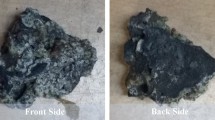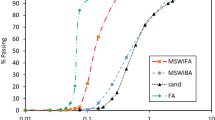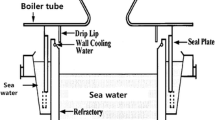Abstract
This study analyzed the characteristics of reject ash and bottom ash as raw materials for lightweight aggregate and suggested an optimum mixing ratio for recycling coal ash. The physical and chemical properties of reject ash and bottom ash for the manufacture of lightweight aggregate were examined. Rapid sintering tests were conducted to find an optimum mixing ratio to produce lightweight aggregates, density was measured, and cross-sections were observed. XRD-CT analysis was performed to observe the crystal phase distribution of the lightweight aggregate. Aggregate was sintered in a pilot rotary kiln using the optimum mixing ratio obtained through the experiment and its properties were measured. Coal ash has been found to be an unsuitable raw material for producing lightweight aggregate. By adding 3 wt% of carbon and 5 wt% of Fe2O3 to the bottom ash-dredged soil mixture, it was possible to prevent the adhesion of aggregate at the bloating activation temperature by lowering the firing temperature. Aggregates manufactured in the pilot rotary kiln meet the relevant standards and exhibit properties similar to those of commercial aggregates.












Similar content being viewed by others
References
M.V. Madurwar, R.V. Ralegaonkar, S.A. Mandavgane, Application of agro-waste for sustainable construction materials: a review. Constr. Build. Mater. 38, 872–878 (2013)
G. Joseph, K. Ramamurthy, Influence of fly ash on strength and sorption characteristics of cold-bonded fly ash aggregate concrete. Constr. Build. Mater. 23, 1862–1870 (2009)
J. Monzo, J. Paya, M.V. Borrachero, A. Corcoles, Use of sewage sludge ash(SSA)-cement admixtures in mortars. Cem. Concr. Res. 26(9), 1389–1398 (1996)
T. Kim, J.M. Davis, M.T. Ley, S. Kang, P. Amrollahi, Fly ash particle characterization for predicting concrete compressive strength. Constr. Build. Mater. 165, 560–571 (2018)
K.S. Al-Jabri, M. Hisada, Salem K. Al-Oraimi, A.H. Al-Saidy, Copper slag as sand replacement for high performance concrete. Cem. Concr. Compos. 31, 483–488 (2009)
N. Saikia, S. Kato, T. Kojima, Production of cement clinkers from municipal solid waste incineration (MSWI) fly ash. Waste Manag. 27(9), 1178–1189 (2007)
Y. Li, L. Hao, X. Chen, Analysis of MSWI bottom ash reused as alternative material for cement production. Procedia Environ. Sci. 31, 549–553 (2016)
J.H. Kim, K.G. Lee, Y. Kim, S.K. Kang, Efflorescence and leaching behavior of metal ions for EAF dust-clay based bricks. Mater. Sci. Forum 449–452, 241–244 (2004)
C. Yang, C. Cui, J. Qin, Recycling of low-silicon iron tailings in the production of lightweight aggregates. Ceram. Int. 41, 1213–1221 (2015)
B. Ayati, C. Molineux, D. Newport, C. Cheeseman, Manufacture and performance of lightweight aggregate from waste drill cuttings. J. Clean. Prod. 208(20), 252–260 (2019)
J.M. Moreno-Maroto, B. Gonzalez-Corrochano, J. Alonso-Azcarte, L. Rodriguez, A. Acosta, Manufacturing of lightweight aggregates with carbon fiber and mineral wastes. Cem. Concr. Compos. 83, 335–348 (2017)
F. Abd EL-Raoof, A.M.M. Soltan, W.A. Kahl, N.A. Abdel-Kader, M. Abdel-Kader Serry, B. Abdel-Hamid El-Kaliouby, Lightweight aggregates from mixtures of granite wastes with clay. J. Clean. Prod. 117, 139–149 (2016)
J. Guo, L. Zhang, W. Wang, H. Zhang, X. Liu, M. Liu, Effect of SiO2 and Al2O3 on characteristics of lightweight aggregate made from sewage sludge and river sediment. Ceram. Int. 44(4), 4313–4319 (2017)
C.H. Huang, S.Y. Wang, Application of water treatment sludge in the manufacturing of lightweight aggregate. Constr. Build. Mater. 43, 174–183 (2013)
I.M. Anagnostopoulos, V.E. Stivanakis, Utilization of lignite power generation residues for the production of lightweight aggregates. J. Hazard. Mater. 163, 329–336 (2009)
M.C. Han, D. Han, J.K. Shin, Use of bottom ash and stone dust to make lightweight aggregate. Constr. Build. Mater. 99, 192–199 (2015)
M.A. Kang, S. Kang, Effect of activated carbon on bloating properties of artificial lightweight aggregates containing coal reject ash and bottom ash. J. Korean Cryst. Growth Cryst. Technol. 23(4), 201–206 (2013)
Y.L. Wei, S.H. Cheng, G.W. Ko, Effect of waste glass addition on lightweight aggregates prepared from F-class coal fly ash. Constr. Build. Mater. 112, 773–782 (2016)
C.L. Hwang, L.A.T. Bui, K.L. Lin, C.T. Lo, Manufacture and performance of lightweight aggregate from municipal solid waste incinerator fly ash and reservoir sediment for self-consolidating lightweight concrete. Cem. Concr. Compos. 34(10), 1159–1166 (2012)
S.H. Kang, K.G. Lee, Y.T. Kim, S.G. Kang, Effects of chemicophysical properties of carbon on bloating characteristics of artificial lightweight aggregates using coal ash. Ceram. Trans. 232, 35–42 (2012)
K. Laursen, T.J. White, D.J.F. Cresswell, P.J. Wainwright, J.R. Barton, Recycling of an industrial sludge and marine clay as light-weight aggregates. J. Environ. Manag. 80(3), 208–213 (2006)
S.H. Kang, K.G. Lee, Bloating mechanism of artificial lightweight aggregate for recycling the waste glass. J. Korean Ceram. Soc. 47(5), 445–449 (2010)
Yearbook of Energy Statistics 2018, (Korea Energy Economics Institute, 2018), pp. 155
Y.L. Wei, S.H. Cheng, G.W. Ko, Effect of waste glass addition on lightweight aggregates prepared from F-class coal fly ash. Constr. Bulid. Mater. 112, 773–782 (2016)
S. Mu, B. Ma, G.D. Schutter, X. Li, Y. Wang, S. Jian, Effect of shale addition on properties of sintered coal fly ash. Constr. Bulid. Mater. 25, 617–622 (2011)
K.G. Lee, Bloating mechanism for artificial light weight aggregate of surface modification with coal ash. J. Korean Ceram. Soc. 52(2), 159–164 (2015)
K.G. Lee, Boating mechanism for coal ash with iron oxide. J. Korean Cryst. Growth Cryst. Technol. 24(2), 77–83 (2014)
K.G. Lee, Bloating mechanism of artificial lightweight aggregate with reject ash. J. Korean Cryst. Growth Cryst. Technol. 22(3), 158–163 (2012)
Y. Kim, Y. Ryu, C. Jang, K. Lee, S. Kang, J. Kim, A study on the black core formation of artificial lightweight aggregates at various sintering atmospheres. J. Korean Cryst. Growth Cryst. Technol. 19(6), 318–323 (2009)
K.H. Lee, J.H. Lee, Y.M. Wie, K.G. Lee, Bloating mechanism of lightweight aggregate due to ramping rate. Adv. Mater. Sci. Eng. 2019, 1–12 (2019)
S.G. Kang, K.G. Lee, Y.T. Kim, K.D. Kim, S.N. Cho, (Kyonggi Univ.) Artificial light-weight aggregates made of ceramic oxides to prevent sticking phenomenon, Kor. Patent 10-2014-0052249, April 30 (2014)
KS L 5405: Fly ash (2018)
KS F 2503: Testing method for density and absorption of coarse aggregate (2007)
C.M. Riley, Relation of chemical properties to the bloating of clays. J. Am. Ceram. Soc. 34(4), 121–128 (1951)
G. Cougny, Specifications for clayey raw materials used to produce expanded lightweight aggregates. Bull. Int. Assoc. Eng. Geol. 41(1), 47–55 (1990)
Y.M. Wie, K.G. Lee, Optimum bloating-activation zone of artificial lightweight aggregate by dynamic parameters. Materials (Basel) 12(2), 267 (2019)
Y.M. Wie, K.G. Lee, K.H. Lee, Optimum condition for the unit process of an artificial lightweight aggregate using the Taguchi method. J. Asian Ceram. Soc. 7(3), 331–341 (2019)
J.Y. Park, Y.T. Kim, K.G. Lee, S.G. Kang, J.H. Kim, The mechanism of black core formation. J. Korean Cryst. Growth Cryst. Technol. 15(5), 208–215 (2005)
S. Köse, G. Bayer, Schaumbildung im system altglas-SiC und die eigenschaften derartiger schaumgläser. Glas. Ber. 55(7), 151–160 (1982)
O.V. Kaz’mina, V.I. Vereshchagin, A.N. Abiyaka, Y.V. Popletneva, Viscosity evaluation for glass and glass crystal compositions in their foaming temperature range. Glas. Ceram. 66(7–8), 236–239 (2009)
K.G. Lee, Bloating mechanism of lightweight aggregate with the size. J. Korean Ceram. Soc. 53(2), 241–245 (2016)
M. Aineto, A. Acosta, J.M. Rincón, M. Romero, Thermal expansion of slag and fly ash from coal gasification in IGCC power plant. Fuel 85(6), 2352–2358 (2006)
KS F 2527 Concrete aggregate (2018)
Acknowledgements
This work was supported by Kyonggi University Research Grant 2018.
Author information
Authors and Affiliations
Corresponding author
Additional information
Publisher's Note
Springer Nature remains neutral with regard to jurisdictional claims in published maps and institutional affiliations.
Rights and permissions
About this article
Cite this article
Wie, Y.M., Lee, K.G. Composition design of the optimum bloating activation condition for artificial lightweight aggregate using coal ash. J. Korean Ceram. Soc. 57, 220–230 (2020). https://doi.org/10.1007/s43207-020-00025-0
Received:
Accepted:
Published:
Issue Date:
DOI: https://doi.org/10.1007/s43207-020-00025-0




